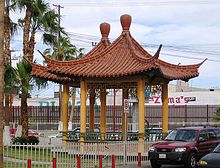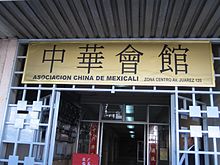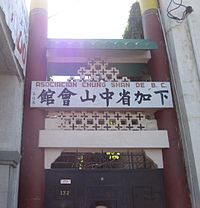- Chinatown, Mexicali
-
Chinatown, Mexicali is claimed to have the largest per capita concentration of residents of Chinese origin, around 5,000, by Mexicali. While this does not compare to U.S. cities like San Francisco or New York, early in the 20th century Mexicali was numerically and culturally more Chinese than Mexican. The Chinese arrived to the area as laborers for the Colorado River Land Company, an American enterprise which designed and built an extensive irrigation system in the Valley of Mexicali. Some immigrants came from the United States, often fleeing anti-Chinese policies there, while others sailed directly from China. Thousands of Chinese were lured to the area by the promise of high wages, but for most that never materialised.[1]
Contents
History
Many of the Chinese labourers who came to the irrigation system stayed on after its completion, congregating in an area of Mexicali today known as Chinesca ('Chinatown'). During Prohibition in the U.S., many Chinese laborers and farmers came to the town to open bars, restaurants and hotels to cater their American clients, Chinesca eventually housed just about all of the city's casinos and bars, and an underground tunnel system to connect bordellos and opium dens to Calexico on the U.S. side. Bootleggers also used this route to supply the U.S. with alcohol purchased in Mexico.[1]
By 1920, Mexicali's Chinese population outnumbered the Mexican 10,000 to 700.[2] A group of 5,000 single Chinese males started the Asociación China, a Mexicali's social organization at least partly devoted to finding Chinese wives from overseas, which remains active today. In 1927, a series of Tong wars here and other parts of Northern Mexico erupted over control of gambling and prostitution rings. Mexican alarm over the Chinese organized crime led to the government-encouraged Movimiento Anti-Chino. In the late 1920s, a wave of anti-immigrant sentiment that swept the country and led to the torture and murder of hundreds of Chinese in northern Mexico. However, the Chinese in this city were numerous enough and politically strong enough to protect themselves.
The percentage of Chinese was so high here that in the 1940s the town had only two cinemas, both of which played Chinese movies almost exclusively. However, in the latter half of the 20th century, steady influx of Mexican migrants here diluted the Chinese population, until once again they became a minority.[1]
After anti-Chinese sentiment faded, more Chinese arrived here, and it became the Mexican headquarters for the Kuomintang, or the Nationalist Chinese Party and the Anti-Communist League.[3] After events during World War II and the communist revolution in China, a large number of Chinese refugees came to Mexico in the mid-century. Ho Feng-Shan, the Chinese diplomat known as "China's Schindler" is known to have visited Mexicali.[4] The town was the site of the Taiwan based Republic of China consulate in the 1960s until Mexico withdrew its recognition of the island nation, ending immigration of ethnic Chinese to this area.[1] For a while after 1960, Chinese Mexican community organizations continued to stay strong: at the beginning of the 1960s new Chinese Mexican seminaries continued to open, and in the 1970s a school opened to teach art, Chinese culture, and sports to Chinese Mexicans living in downtown Mexicali.[5]
Chinatown today
La Chinesca, or Chinatown, still survives near the border close to the intersection of Avenida Madero and Calle Melgar,although it is much smaller than in the past. However, Mexicali still boasts more Chinese restaurants per capita than any other city in Mexico, more than 100 for the whole town, most with Cantonese-style cuisine. Local Chinese associations struggle to preserve the arts and culture of the homeland through the sponsorship of Chinese festivals, calligraphy clubs, and language classes. However, much of Chinese cultural life here has blended with local Mexican and American traditions to create a unique, hybrid culture.[1]
Like many Chinese restaurants outside of Asia, cooks here have adapted their native cuisine to local tastes. For example, restaurants here serve their dishes with a small bowl of a sauce that is similar to a generic steak sauce, common in Northern Mexico. In many of these restaurants, it is not uncommon to see Chinese men wearing stiff straw cowboy hats, meeting over hamburgers and green tea and speaking a mixture of Cantonese and Spanish. Along with burgers and chow mein, many restaurants here also offer shark-fin tacos.[1]Since 2000, new migrants from China to Mexicali come from many of the same areas as before 1960, with perhaps 90% from Guangdong or Hong Kong.[6]
Recently a successful Chinese businessman Angel Zhen along with other prominent Chinese business owners established the Chamber of Chinese Entrepreneurs. The chamber was established to expand resources and to connect all Chinese Associations from each city and state in the northwestern region of Mexico (Baja California, Baja California Sur, Sonora, and Chihuahua). The Chamber serves and works actively to defend the legitimate rights and interests of Chinese business associations in the region. The Chamber is also responsible for raising the social status and influence of its associates.
See also
- Chinese immigration to Mexicali
- Chinatown
- Chinatown, New York
- Chinatown, Los Angeles
- Chinatown, San Francisco
- Chinatown, Oakland
References
- ^ a b c d e f Cummings, Joe. "Mexicali's Chinatown: Sharks fin Tacos and Barbecued Chow Mein". http://www.cpamedia.com/history/sharks_fin_tacos/. Retrieved 2008-10-25.
- ^ Stacy, Lee. 2003. Mexico and the United States p. 183
- ^ http://books.google.com/books?id=_jdS9J_nNugC&lpg=PA177&ots=THRHyOtGGX&dq=kuomintang%20mexicali&pg=PA177#v=onepage&q=kuomintang%20mexicali&f=false
- ^ http://books.google.com/books?id=_jdS9J_nNugC&pg=PA177&lpg=PA177&dq=kuomintang+mexicali&source=bl&ots=THRHyOtGGX&sig=GK03BSc3A0gGIPKf6hcnI-v0rtI&hl=en&ei=cpgsTf3-CoecsQPehMDuBQ&sa=X&oi=book_result&ct=result&resnum=7&ved=0CEAQ6AEwBg#v=onepage&q=kuomintang%20mexicali&f=false
- ^ Auyón Gerardo, Eduardo. 2003. El dragón en el desierto: los pioneros chinos en Mexicali. p. 103-104
- ^ Auyón Gerardo, Eduardo. 2003. El dragón en el desierto: los pioneros chinos en Mexicali. Mexicali, Baja California: Centro de Investigación de la Cultura China
External links
 State of Baja California
State of Baja CaliforniaMexicali (capital) Major cities 
Regions Baja California Desert · Baja California Gold Coast · Colorado River Delta · Sierra Juárez and San Pedro Mártir pine-oak forests
Metro areas Municipalities Ensenada · Mexicali · Rosarito Beach · Tecate · Tijuana
Chinatowns Africa South Africa: JohannesburgAsia India: Kolkata · Makum (closed) · Mumbai (closed), Indonesia: Jakarta, Iran: Mahale Chiniha, Japan: Kobe · Nagasaki · Yokohama, Malaysia: Kuala Lumpur, Myanmar: Yangon, Pakistan: Karachi, Philippines: Manila, Singapore Singapore, South Korea: Incheon, Thailand: Bangkok, United Arab Emirates: Dubai, Vietnam: Ho Chi Minh City (Saigon)Europe Latin America Argentina: Buenos Aires, Brazil: São Paulo, Costa Rica: San José, Cuba: Havana, Mexico: Mexicali · Mexico City, Peru: LimaNorth America Canada: Calgary · Edmonton · Lethbridge · Montreal · Ottawa · Toronto · Vancouver · Victoria · Winnipeg
United States: Boston · Brooklyn · Chicago · Cleveland · Flushing · Honolulu · Houston · Las Vegas · Los Angeles · Newark · New York · Oakland · Oklahoma City · Philadelphia · Portland · San Francisco · Seattle · Washington D.C.Oceania Categories:- Mexicali
- Chinatowns in Mexico
- Restaurant districts and streets
Wikimedia Foundation. 2010.




